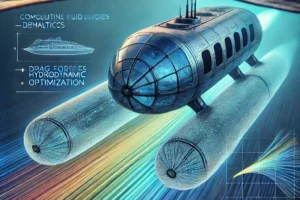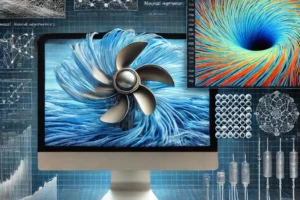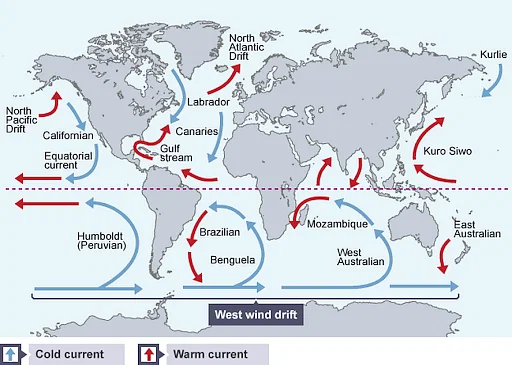Ocean currents are large-scale movements of water in the Earth’s oceans, driven by a variety of factors including wind, temperature, and differences in water density. They play a crucial role in regulating the Earth’s climate and distributing heat around the planet. We’ll further explore ocean current measurement.
There are two main types of ocean currents: surface currents and deep ocean currents. Surface currents are driven by the wind and primarily affect the upper layer of the ocean, while deep ocean currents are driven by differences in water density and typically move at much slower speeds.
Surface currents are divided into two categories: gyres and coastal currents. Gyres are large circular currents that dominate the open ocean and are driven by the combined effects of the Earth’s rotation and prevailing winds. There are five major gyres in the world’s oceans: the North Atlantic Gyre, the South Atlantic Gyre, the North Pacific Gyre, the South Pacific Gyre, and the Indian Ocean Gyre. Coastal currents, on the other hand, are influenced by local wind patterns and are found along the shorelines of continents and islands.
Deep ocean currents are driven by differences in water density, which in turn are influenced by temperature and salinity. Cold, dense water sinks to the bottom of the ocean and flows along the ocean floor, while warmer, less dense water rises to the surface. This movement of water helps to distribute heat around the planet and plays a crucial role in regulating the Earth’s climate.
Overall, ocean currents play a crucial role in shaping the Earth’s climate and are essential for maintaining the health of the planet’s ecosystems. By transporting nutrients and heat around the planet, ocean currents help to support the complex web of life that exists in the world’s oceans.
What is Ocean Current Measurement?
Ocean current measurement is a complex and challenging task that requires advanced technologies and specialized equipment. There are a variety of methods used to measure ocean currents, each with its own strengths and limitations.
One common method of ocean current measurement is through the use of satellite remote sensing. Satellites equipped with altimeters can measure the height of the sea surface, which can be used to calculate the speed and direction of surface currents. However, this method is limited to surface currents and cannot measure the deeper, slower-moving currents.
Another method of ocean current measurement is through the use of drifters and floats. These instruments are equipped with sensors that measure ocean temperature, salinity, and pressure, allowing researchers to track the movement of water masses over time. Drifters and floats can be deployed in large numbers, providing a comprehensive picture of ocean currents over a wide area.
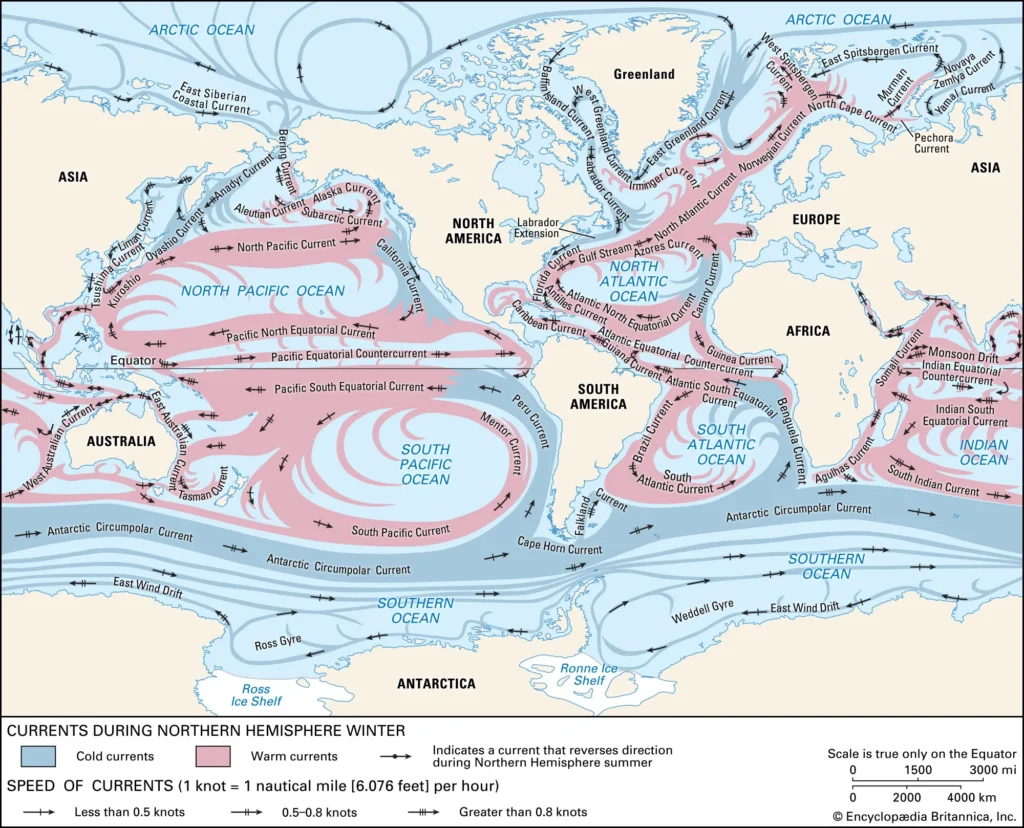
Acoustic Doppler Current Profilers (ADCPs) are another common tool used in ocean current measurement. ADCPs use sound waves to measure the speed and direction of ocean currents at various depths. This method is particularly useful for measuring the deeper, slower-moving currents that are not detectable by satellite remote sensing.
In addition to these methods, ship-based measurements using current meters, thermometers, and other instruments are also used to measure ocean currents. However, this method is time-consuming and expensive, making it less practical for large-scale ocean current studies.
Overall, ocean current measurement is a challenging and complex task that requires a combination of advanced technologies and specialized equipment. By using a variety of methods, researchers are able to gain a comprehensive understanding of ocean currents and their role in shaping the Earth’s climate and ecosystems.
Method
Ocean current measurement can be done using various methods, depending on the depth of the water, the required accuracy, and the available resources. In this response, I will provide a detailed explanation of some of the most common methods used to measure ocean currents.
- Acoustic Doppler Current Profilers (ADCPs): ADCPs are instruments that use sound waves to measure the speed and direction of ocean currents. They work by emitting sound waves at a known frequency and measuring the frequency shift of the waves as they bounce back off moving particles in the water. The difference in frequency between the emitted and received sound waves can be used to calculate the speed and direction of the water particles.
ADCPs can be mounted on the bottom of a ship or on a mooring to measure currents at various depths. They can measure currents over a range of depths, from just below the surface to several hundred meters deep. ADCPs are particularly useful for measuring the deeper, slower-moving currents that are not detectable by satellite remote sensing.
- Satellite Remote Sensing: Satellites equipped with altimeters can measure the height of the sea surface, which can be used to calculate the speed and direction of surface currents. This method is particularly useful for large-scale studies of ocean currents and can provide a broad view of ocean circulation patterns. However, it is limited to surface currents and cannot measure the deeper, slower-moving currents.
- Drifters and Floats: Drifters and floats are instruments that are deployed in the ocean and track the movement of water masses over time. They are equipped with sensors that measure ocean temperature, salinity, and pressure. Drifters and floats can be deployed in large numbers, providing a comprehensive picture of ocean currents over a wide area.
Drifters are designed to float on the ocean surface and are carried by surface currents. They typically have a drogue or sea anchor that hangs below the surface, allowing them to track the movement of water at different depths. Floats, on the other hand, are designed to sink to a predetermined depth and drift with the water masses at that depth.
- Ship-based measurements: Ship-based measurements are a time-consuming and expensive method of measuring ocean currents, but they can provide high-quality data on currents at specific locations. Ship-based measurements can be made using current meters, which are instruments that measure the speed and direction of water flow, as well as thermometers and other instruments to measure temperature, salinity, and other variables.
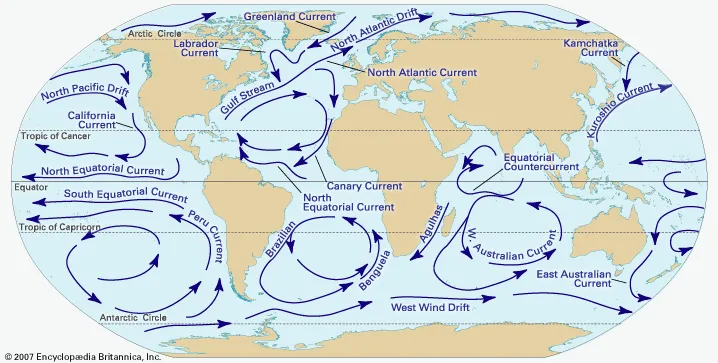
Overall, ocean current measurement requires a combination of advanced technologies and specialized equipment. By using a variety of methods, researchers can gain a comprehensive understanding of ocean currents and their role in shaping the Earth’s climate and ecosystems.
Uses and Importance
Ocean currents play a critical role in shaping the Earth’s climate and ecosystems, and their measurement is essential for understanding and predicting the impacts of climate change. Here are some of the primary uses and importance of measuring ocean currents:
- Climate modeling: Ocean currents transport heat from the tropics to the poles, affecting global climate patterns. By measuring ocean currents, researchers can improve climate models and predict how climate change will affect ocean circulation and temperature.
- Marine ecosystem monitoring: Ocean currents transport nutrients, plankton, and other organisms throughout the ocean, affecting the distribution and abundance of marine life. Measuring ocean currents can help researchers understand and predict the impacts of climate change and other human activities on marine ecosystems.
- Navigation and safety: Ocean currents can affect the speed and direction of ships, making navigation challenging and potentially dangerous. Measuring ocean currents can help improve navigation safety and optimize shipping routes.
- Natural resource management: Ocean currents affect the distribution of fish stocks, oil spills, and other natural resources. Measuring ocean currents can help improve resource management and reduce the impacts of environmental disasters.
- Renewable energy: Ocean currents can be used to generate electricity through the use of tidal and current energy turbines. Measuring ocean currents is essential for identifying the most suitable locations for these turbines and maximizing their energy output.
In summary, ocean current measurement is crucial for understanding and predicting the impacts of climate change, managing marine ecosystems and resources, improving navigation safety, and developing renewable energy sources. By using a variety of methods to measure ocean currents, researchers can gain a comprehensive understanding of their role in shaping the Earth’s climate and ecosystems.
Conclusion
In conclusion, ocean currents play a vital role in shaping the Earth’s climate and ecosystems, and their measurement is essential for understanding and predicting the impacts of climate change. Ocean currents transport heat, nutrients, and organisms throughout the ocean, affecting global climate patterns, marine ecosystems, and natural resources. Measuring ocean currents can help improve climate models, predict the impacts of human activities on marine ecosystems, improve navigation safety, and develop renewable energy sources.
The use of advanced technologies and specialized equipment is necessary for measuring ocean currents. Acoustic Doppler Current Profilers (ADCPs), satellite remote sensing, drifters and floats, and ship-based measurements are some of the most common methods used to measure ocean currents. ADCPs use sound waves to measure the speed and direction of ocean currents, while satellite remote sensing measures the height of the sea surface to calculate the speed and direction of surface currents. Drifters and floats are equipped with sensors that measure ocean temperature, salinity, and pressure, while ship-based measurements use current meters, thermometers, and other instruments to measure water flow and other variables.
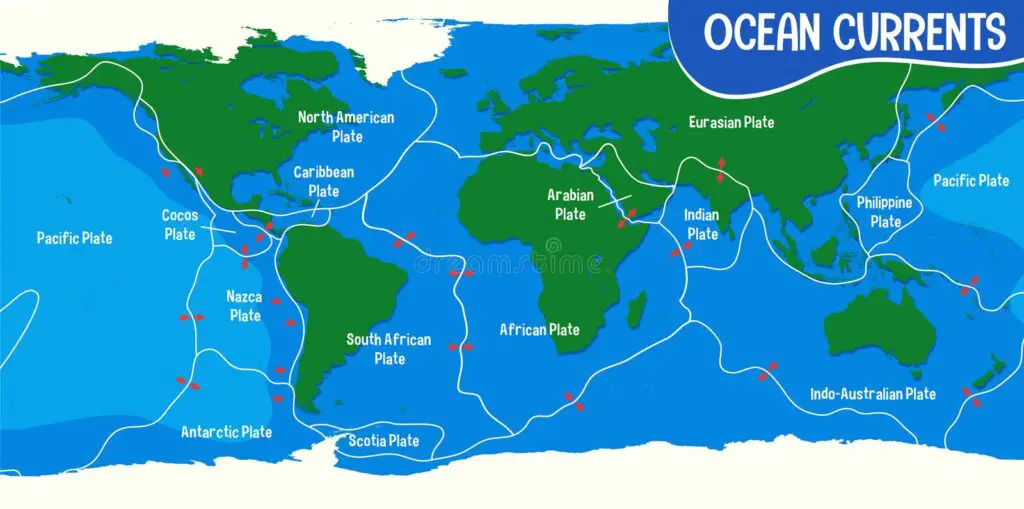
The importance of measuring ocean currents lies in their significant impact on climate patterns, marine ecosystems, navigation safety, and natural resources. Climate modeling relies on accurate measurements of ocean currents to predict the impacts of climate change on ocean circulation and temperature. Marine ecosystem monitoring requires measurements of ocean currents to understand the distribution and abundance of marine life and predict the impacts of climate change and other human activities. Navigation safety can be improved by measuring ocean currents to optimize shipping routes and reduce the risk of accidents. Natural resource management can be enhanced by measuring ocean currents to identify the distribution of fish stocks, oil spills, and other natural resources.
In conclusion, ocean current measurement is crucial for understanding and predicting the impacts of climate change, managing marine ecosystems and resources, improving navigation safety, and developing renewable energy sources. The use of advanced technologies and specialized equipment provides researchers with a comprehensive understanding of ocean currents and their role in shaping the Earth’s climate and ecosystems. As such, continued investment in ocean current measurement technologies is critical for ensuring the sustainability of the Earth’s environment and the future of human society.

